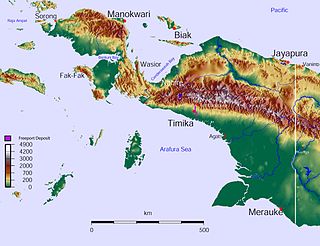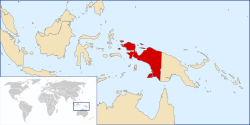
Dutch New Guinea or Netherlands New Guinea was the western half of the island of New Guinea that was a part of the Dutch East Indies until 1949, later an overseas territory of the Kingdom of the Netherlands from 1949 to 1962. It contained what are now Indonesia's six easternmost provinces, Central Papua, Highland Papua, Papua, South Papua, Southwest Papua, and West Papua, which were administered as a single province prior to 2003 under the name Irian Jaya, and now comprise the Papua region of the country.

The Free Papua Movement or Free Papua Organization is an independence movement based on Western New Guinea, seeking liberation of the territory from colonial Indonesian administration. The territory is currently divided into six Indonesian provinces of Central Papua, Highland Papua, Papua, South Papua, Southwest Papua, and West Papua, also formerly known as Papua, Irian Jaya and West Irian.

West Papua, formerly Irian Jaya Barat, is an Indonesian province located in the land of Papua. It covers most of the two western peninsulas of the island of New Guinea, the eastern half of the Bird's Head Peninsula and the whole of the Bomberai Peninsula, along with nearby smaller islands. The province is bordered to the north by the Pacific Ocean, to the west by Southwest Papua Province, the Halmahera Sea and the Ceram Sea, to the south by the Banda Sea, and to the east by the province of Central Papua and the Cenderawasih Bay. Manokwari is the province's capital and largest city. With an estimated population of 561,403 in mid-2022, West Papua is the least populous province in Indonesia after Southwest Papua, which was a part of West Papua until separated off in 2022.

The Republic of West Papua, alternatively known as the Federal Republic of West Papua is a quasi-state consisting of the Western New Guinea region, which is currently part of Indonesia on the continent of Oceania. The region has been part of Indonesia since 1 May 1963 under several names in the following order, West Irian, Irian Jaya, and Papua. Today the region comprises six Indonesian provinces: Papua, Central Papua, Highland Papua, South Papua, West Papua, and Southwest Papua.

The New York Agreement is an agreement signed by the Netherlands and Indonesia regarding the administration of the territory of Western New Guinea. The first part of the agreement proposes that the United Nations assume administration of the territory, and a second part proposes a set of social conditions that will be provided if the United Nations exercises a discretion proposed in article 12 of the agreement to allow Indonesian occupation and administration of the territory. Negotiated during meetings hosted by the United States, the agreement was signed on 15 August 1962 at the United Nations Headquarters in New York City, United States.

The Act of Free Choice was a controversial plebiscite held between 14 July and 2 August 1969 in which 1,025 people selected by the Indonesian military in Western New Guinea voted unanimously in favor of Indonesian control.

Western New Guinea, also known as Papua, Indonesian New Guinea, and Indonesian Papua, is the western half of the island of New Guinea granted to Indonesia in 1962. Given the island is alternatively named Papua, the region is also called West Papua.

The Morning Star flag was a flag used in Netherlands New Guinea for official purposes in addition to the flag of the Netherlands. It was first raised on 1 December 1961. The territory would come under the administration of the United Nations Temporary Executive Authority (UNTEA) on 1 October 1962 and would be transferred to Indonesian control on 1 May 1963. Today, the flag represents the Republic of West Papua, a proposed country consisting of the Western New Guinea region, which is currently administered as part of Indonesia in the continent of Oceania.
This article surveys the postage stamps and postal history of Western New Guinea, particularly in 1949–1963.
The West Irian rupiah was a distinct currency of West Irian between 1963 and 1973. It replaced the West New Guinea gulden at par and was replaced by the Indonesian rupiah at the rate of 1 West Irian rupiah = 18.9 Indonesian rupiah.

Frans Kaisiepo was a Papuan politician and Indonesian nationalist. He served as the fourth Governor of Papua Province. In 1993, Kaisiepo was posthumously declared a National Hero of Indonesia for his lifelong efforts to unite West Irian with Indonesia. As the representative of Papua province, he was involved in the Malino Conference, where the formation of the United States of Indonesia was discussed.

New Guinea is the world's second-largest island, with an area of 785,753 km2 (303,381 sq mi). Located in Melanesia in the southwestern Pacific Ocean, the island is separated from Australia by the 150-kilometre wide Torres Strait, though both landmasses lie on the same continental shelf, and were united during episodes of low sea level in the Pleistocene glaciations as the combined landmass of Sahul. Numerous smaller islands are located to the west and east. The island's name was given by Spanish explorer Yñigo Ortiz de Retez during his maritime expedition of 1545 due to the resemblance of the indigenous peoples of the island to those in the African region of Guinea.

The Papua conflict is an ongoing conflict in Western New Guinea (Papua) between Indonesia and the Free Papua Movement. Subsequent to the withdrawal of the Dutch administration from the Netherlands New Guinea in 1962 and implementation of Indonesian administration in 1963, the Free Papua Movement has conducted a low-intensity guerrilla war against Indonesia through the targeting of its military, police, as well as civilian populations.

The New Guinea Council was a unicameral representative body formed in the Dutch overseas territory of Netherlands New Guinea in 1961.

Viktor Kaisiepo, also spelled Victor Kaisiepo, was a Netherlands New Guinean-born Dutch activist for West Papuan independence and self-determination. His family fled West Papua when its administration was transferred to Indonesia, and he lived in the Netherlands thereafter.
The History of Western New Guinea refers to the history of the Indonesian western half of the island of New Guinea and other smaller islands to its west. This region was previously named Irian Jaya. The eastern half of the island is Papua New Guinea.

This is a survey of the postage stamps and postal history of the Netherlands East Indies, otherwise known as the Dutch East Indies, and which today is known as Indonesia.

Operation Trikora was a combined Soviet-Indonesian military operation which aimed to seize and annex the Dutch overseas territory of Netherlands New Guinea in 1961 and 1962. After negotiations, the Netherlands signed the New York Agreement with Indonesia on 15 August 1962, relinquishing control of Western New Guinea to the United Nations.

Komando Daerah Militer XVII/Cenderawasih or Kodam XVII/Cenderawasih, is a military area command of the Indonesian Army, as the 17th Kodam, which is responsible for the defense of the provinces of Papua, South Papua, Central Papua and Highland Papua.

The West New Guinea dispute (1950–1962), also known as the West Irian dispute, was a diplomatic and political conflict between the Netherlands and Indonesia over the territory of Dutch New Guinea. While the Netherlands had ceded sovereignty over most of the Dutch East Indies to Indonesia on 27 December 1949 following an independence struggle, it retained control over its colony on the western half of New Guinea. The Indonesian government claimed this territory as well, on the basis that it had belonged to the Dutch East Indies and that the new Republic of Indonesia was the legitimate successor to the former Dutch colony.




















